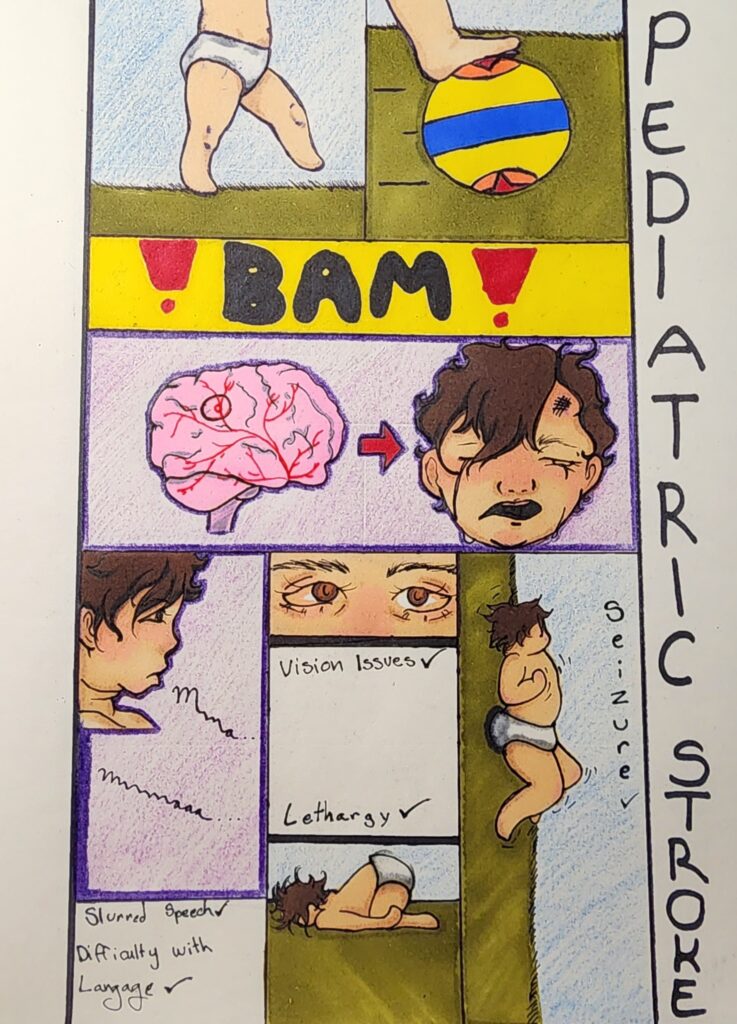
STEAM Project: Pediatric Stroke
My topic of interest for this project was focused on the key objective of knowing the pathway in which the blood flows throughout the heart and the remaining circulatory system particularly that which deals with the brain.
As can be seen, in my comic/symptoms poster an infant suffers from blunt-force trauma due to falling and hitting the ground, leading to hemorrhaging in the brain. Hemorrhaging severely affects blood flow in a multitude of ways, due to —in this case— causing blood to flow out into interstitial space between the brain and the skull. Due to this unnatural flow, blood begins to pool within these spaces, and the vasculature is damaged, which in the case of the infant, will suffer a stroke (Johnson & Burns, 2023, Betts et al.,2022) Strokes are a devastating experience, due to the loss of oxygen within the central nervous system, coupled with a developing brain and we can see the disastrous issues occurring due to this loss of properly oxygenated blood transported via the bloodstream pumped by the heart(Betts et al.,2022). I would like to add that though blunt force trauma is a common way in which pediatric stroke can occur, it is not the only way. There is a laundry list of conditions that can cause these strokes to occur such as diseases in relation to blood vessels, cardiac processes, coagulation issues, renal disease, autoimmune disease, and metabolic disorders (Hollist et al., 2021).
Though an uncommon occurrence with roughly, “one in every 4,000 newborns and an additional 2,000 older children” being affected by such a condition, the effects on a child who unfortunately experience such trauma are immense and can often lead to death (Pediatric Stroke, 2019). This is due to the higher metabolic activity which a pediatric brain experiences, causing an increased susceptibility to neurological damage (Hollist et al., 2021). In many cases of pediatric stroke medical evaluation is delayed, though even with the delay of medical attention, chances of survival are significantly increased with minor long-term neurological issues occurring (Hollist et al., 2021).
Much like in adults, the symptoms which an infant may experience are often the same. Referring to my poster, we can see that, weakness/drooping of an affected side of the body is common, as well as slurred speech, vision issues (double vision/vision loss), sudden lethargy, and most jarringly seizure(Pediatric Stroke, 2019). Though there are other symptoms that may occur as well such as cardio-pulmonary dysfunction, headache, nausea/vomiting, loss of balance, and fever (Hollist et al., 2021, Pediatric Stroke, 2019).).
I found that to best display my creative process in this more depressing topic to use more typically childish mediums and colors. Using markers and crayons I found that the subject matter can better be seen through the eyes of another child going through a bit of a mental checklist to better understand what is happening. In a bit of a morbid way, I found the use of bright colors to help portray the dramatic symptoms which are present when this condition occurs. I also felt that the use of an infant would be more impactful in displaying the stark changes which can occur in a child suffering from a stroke, as typically infant children are full of energy and have the ability to just bounce right back upon having a stumble.
~
References:
Betts, J. G., OpenStax College, Desaix, P., Johnson, J. E., Johnson, E. W., Korol, O., Kruse, D., Poe, B., Wise, J., Womble, M. D., & Young, K. A. (2022). Anatomy and Physiology 2e. Amsterdam University Press.
Hollist, M., Au, K., Morgan, L., Shetty, P. A., Rane, R., Hollist, A., Amaniampong, A., & Kirmani, B. F. (2021). Pediatric Stroke: Overview and Recent Updates. Aging and Disease, 12(4), 1043. https://doi.org/10.14336/ad.2021.0219
Johnson, A. B. (2023). Hemorrhage. StatPearls – NCBI Bookshelf. https://www.ncbi.nlm.nih.gov/books/NBK542273/
Pediatric Stroke. (2019) Johns Hopkins Medicine. https://www.hopkinsmedicine.org/health/conditions-and-diseases/stroke/pediatric-stroke

Your animation of a Pediatric Stroke is very nice. I think that your STEAM project really caught my attention. It has really hit close to home. Since I have an infant son that will soon begin to walk it has given awareness and reminded me that although babies can be adventurous they are still very delicate and they are not fully developed which can make them more susceptible to injury. An injury to the brain has many long term effects on the entire body because without proper function of the brain there is a ripple effect on the function of other organs.
I always heard about strokes that occur in adults and the effects that they have like paralysis, slurred language, blurred vision along with many other effects. When someone had a stroke it was normally because of some underlying conditions that lead to secondary illnesses like a stroke. To recover from a stroke is often difficult and from what I have heard it is very difficult for someone to make a full recovery. For a child it can be detrimental because they are still developing and having such an impact on the brain at such early stages can leave lifelong effects. Your project has really made me want to learn more about Pediatric strokes and things that can be done to prevent it or if it does happen what are red flags that should be looked out for. As a new mother many things we learn along the way and learning about many illnesses and their side effects only have pushed me to learn more about my son and things that I can do to help him or anyone that ever experiences this.
(284)